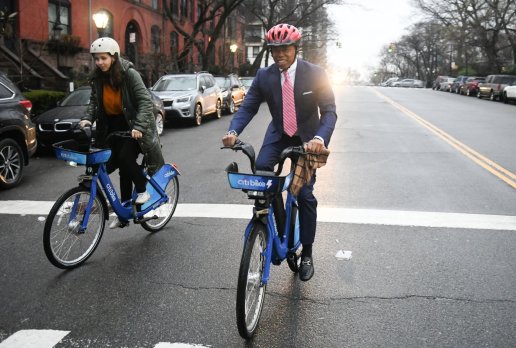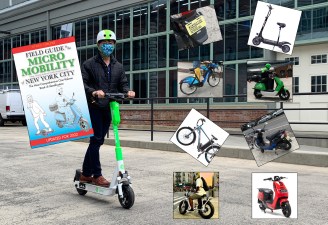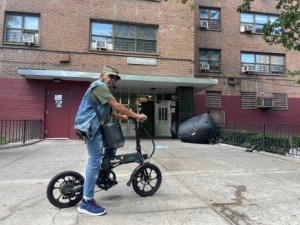Mayor Announces ‘Charge Safe’ Plan to Help Delivery Workers Get Legal Bikes, Safe Batteries

Countering the punitive narrative sweeping the city against electric bikes and other forms of micromobility, Mayor Adams on Monday revealed a new city effort to bolster the “necessary” form of transportation while also reducing the risk of substandard lithium-ion batteries that power some of the vehicles.
The mayor said his “Charge Safe Ride Safe Action Plan” will include possibly creating the kind of “battery-swap” program that was floated one month ago in Streetsblog and later introduced by Council Member Keith Powers. And the plan will finally allow legal e-bikes in city parks.
“This plan commits to designing a safe environment and access program that will help New Yorkers transition away from the illegal mopeds and uncertified bikes and batteries to safe, legal devices and batteries,” the mayor said at a City Hall press conference. “We are also going to lead the nation by piloting options like battery-swapping and safe-charging systems for our delivery workers.”
Details of the plan revealed a mix of new ideas and ongoing efforts that will involve other branches of government. But the mayor spoke passionately about the importance of legal electric bikes as a key to a sustainable transportation future.
“We know [e-bikes] are convenient, but they also are a necessity, particularly for those who are part of this booming economy of delivering food and other items throughout the city,” he said. “[E-bikes] play a major role in help reducing congestion in how we move around the city as we deal with our environmental issues that we are facing. But faulty versions of these e-bikes and illegal electric mopeds … do not meet the basic safety standards and contain uncertified lithium ion batteries. We want to promote the growth of safe e-microbility as a climate friendly alternative to cars.”
He repeatedly blamed “faulty” lithium-ion batteries for the problems fires — fires that are exacerbated by the astounding heat given off by broken batteries and the fact that many people charge substandard batteries in bulk near the very door of their apartment or building, blocking people’s paths to safety.
The mayor’s announcement also came with a mini-bombshell for the users of legal electric bikes: this summer, the city Parks Department will drop its ban on the devices on bike lanes and greenways under its control — a policy that was not consistent with state law.
“We’re going to launch a pilot to allow electric micromobility devices on park drives and greenways to create more safe spaces for New Yorkers to ride,” Hizzoner said. “E-bikes and e-scooters are here. We might as well get used to them. They’re now part of our movement. Now we must make sure they are incorporated in our everyday lives in a safe and efficient manner.”
Beyond that, the “Charge Safe, Ride Safe: New York City’s Electric Micromobility Action Plan” [PDF] offered these specific proposals:
- The city will pilot “Outdoor Electric Micromobility Storage and Charging Solutions at NYCHA Properties”: This is a major change from an earlier initiative by the housing authority to completely ban electric bikes. Under the new plan, the city would eventually install 173 new outdoor charging stations at 53 different NYCHA locations.
- The mayor will “advocate” for the state legislature to pass, and Gov. Hochul to sign, a bill that would subsidize the purchase of safe, legal e-bikes, as reported by Streetsblog.
- The city will continue its effort to create charging hubs for delivery workers.
- The city will continue fire education programs and an NYPD effort to prevent the sale of illegal mopeds by working with business owners who sell them, and, in some cases, shutting them down. “Businesses that continue offering illegal devices for sale have these devices seized and receive summonses. “
One thing left unclear is whether City Hall will create a battery-swap program, such as the one advocated by Streetsblog and Powers (D-Upper East Side). The mayor’s proposal only says that City Hall “will engage with stakeholders and experts, including New York City Council, to design a program adapted to our unique cyclist landscape, focusing on the needs of delivery cyclists and low-income communities.”
SIDEBAR: HOW IS THE LITHIUM-ION BATTERY PROBLEM BEING FACED NATIONALLY?
The mayor’s comments came after Fire Commissioner Laura Kavanagh continued to blame only “e-bikes” for the spate of fires, rather than specifically citing illegal devices, such as unlicensed mopeds, or the faulty, uncertified batteries that have proliferated because they are cheaper and readily available. She did add that the federal Consumer Product Safety Commission — to which FDNY wrote last month seeking federal intervention — has been “incredibly responsive,” mentioning a recall on at least one faulty device and a review of how the federal government can prevent substandard products from entering the country at ports.
The mayor promised ongoing engagement with the Consumer Product Safety Commission, part of City Hall’s multi-government approach. Delivery workers, the mayor said, “should not have to be battery and equipment experts.” It is up to government, he added, “to ensure the products and our streets are safe.”
In addition to announcing his proposal, the mayor signed a slate of bills passed earlier this month by the City Council, including:
- Intro 663 (by Council Member Oswald Feliz), which would prohibit the sale of uncertified batteries or those not approved by reputable organizations such as Underwriters Laboratory. This bill was specifically cited in the mayor’s 35-page plan.
- Intro 752 (Gale Brewer), which would prohibit the sale and assembly of second-use lithium ion batteries. “In layman’s terms, it’s a battery that has been reconstituted,” Brewer said earlier. This bill was also cited in the mayor’s plan.
- Intro 722 (Robert Holden) requires the FDNY to publish an annual report on all fires caused by powered mobility devices, including details like the geographic location and circumstances of each fire, and building type at which it occurred. This was the lone bill in the package that the FDNY opposed — on the grounds that it is not “the best use of resources,” Acting Chief of Fire Prevention at FDNY Thomas Currao testified last year. He raised issues with the trouble the FDNY would have with a bill because of “what it might take to gather and produce all of the elements in this report.”




